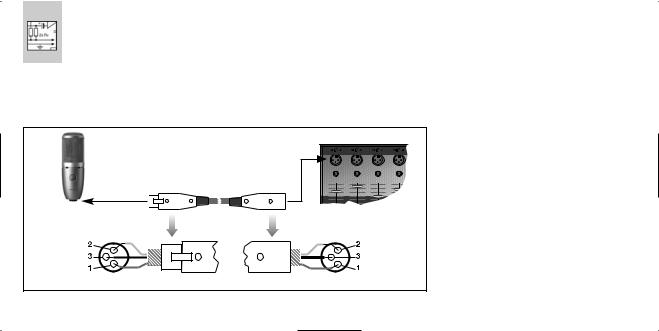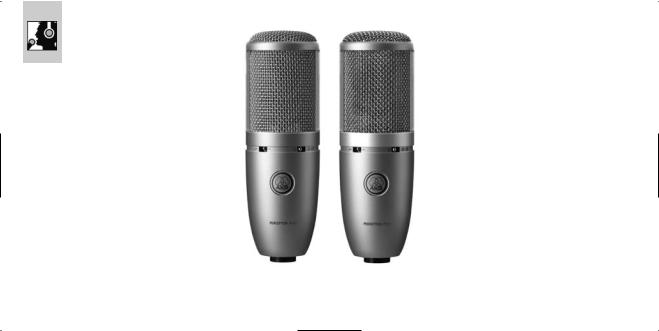Akg Perception 220 User Manual [ru]

PERCEPTION 120
PERCEPTION 220
User Instructions. . . . . . . . . . . . . . . . . . . . . . . . . . . . . p. 2
Please read the manual before using the equipment!
Mode d’emploi . . . . . . . . . . . . . . . . . . . . . . . . . . . . . p. 14
Veuillez lire cette notice avant d’utiliser le système!

Table of Contents
|
|
|
Page |
|
|
|
Page |
1 |
Precaution/Unpacking . . . . . . . . . . . . . . . . . . . . . . . . . . . . . . . . . . |
. . . 3 |
5 |
Cleaning. . . . . . . . . . . . . . . . . . . . . . . . . . . . . . . . . . . . . . . . . . . . . |
. . . 7 |
||
|
1.1 |
Precaution . . . . . . . . . . . . . . . . . . . . . . . . . . . . . . . . . . . . . . |
. . . 3 |
6 Troubleshooting |
|
||
|
1.2 |
Unpacking . . . . . . . . . . . . . . . . . . . . . . . . . . . . . . . . . . . . . . . |
. . 3 |
. . 8 |
|||
2 |
Description . . . . . . . . . . . . . . . . . . . . . . . . . . . . . . . . . . . . . . . . . . . |
. . 3 |
7 |
Specifications . . . . . . . . . . . . . . . . . . . . . . . . . . . . . . . . . . . . . . . . . |
. 10 |
||
|
2.1 |
Introduction . . . . . . . . . . . . . . . . . . . . . . . . . . . . . . . . . . . . . . |
. . 3 |
|
7.1 |
PERCEPTION 120. . . . . . . . . . . . . . . . . . . . . . . . . . . . . . . . . . . |
. 10 |
|
2.2 |
Features . . . . . . . . . . . . . . . . . . . . . . . . . . . . . . . . . . . . . . . . |
. . 3 |
|
7.2 |
PERCEPTION 220. . . . . . . . . . . . . . . . . . . . . . . . . . . . . . . . . . . |
. 11 |
|
2.3 |
Optional Accessories . . . . . . . . . . . . . . . . . . . . . . . . . . . . . . . |
. . 4 |
|
FCC Statement . . . . . . . . . . . . . . . . . . . . . . . . . . . . . . . . . . . . . . . . |
. 11 |
|
|
|
|
|
|
Frequency Response and Polar Diagrams. . . . . . . . . . . . . . . . . . . . . |
. 12 |
|
3 Interfacing . . . . . . . . . . . . . . . . . . . . . . . . . . . . . . . . . . . . . . . . . . . . . . 5
3.1 General . . . . . . . . . . . . . . . . . . . . . . . . . . . . . . . . . . . . . . . . . . . 5 The International Page . . . . . . . . . . . . . . . . . . . . . . . . . . . . . . . . . . . . . 25
3.2 Pinout . . . . . . . . . . . . . . . . . . . . . . . . . . . . . . . . . . . . . . . . . . . . 5
3.3 Connecting the Microphone . . . . . . . . . . . . . . . . . . . . . . . . . . . . 5
4 Using Your Microphone . . . . . . . . . . . . . . . . . . . . . . . . . . . . . . . . . . . . 6
4.1 General Hints . . . . . . . . . . . . . . . . . . . . . . . . . . . . . . . . . . . . . . . 6
2 |
AKG PERCEPTION 120/220 |

! 11.1Precaution/UnpackingPrecaution
Please make sure that the piece of equipment your microphone will be connected to fulfills the safety regulations in force in your country and is fitted with a ground lead.
1.2 Unpacking
Check that the packaging contains all of the items listed for your microphone. Should any item be missing, please contact your AKG dealer.
PERCEPTION 120: |
• Microphone |
|
• Stand adapter |
|
• Mini poster |
PERCEPTION 220: |
• Microphone |
|
• Spider suspension |
|
• Carrying case |
|
• Mini poster |
2 Description
2.1 Introduction
Thank you for purchasing an AKG product. This Manual contains important instructions for setting up and operating your equipment. Please take a few minutes to read the instructions below carefully before operating the equipment and keep the Manual for future reference. Have fun and impress your audience!
The PERCEPTION 120 and PERCEPTION 220 are heavy-duty, rugged condenser microphones built to the same strict quality standards as all other AKG products.
The PERCEPTION 120 uses a 2/3-inch back electret diaphragm, while the PERCEPTION 220 is a true condenser microphone with a 1-inch large diaphragm.
Designed on the basis of AKG’s decades of knowhow and feedback from sound engineers around the world using AKG studio microphones every day, these general-purpose microphones bring AKG stu-
dio quality to the worlds of recording, live sound, and broadcasting.
2.2 Features
The PERCEPTION 120 and 220 share the following features:
•Cardioid polar pattern: The microphone is most sensitive to sounds arriving from in front of it while picking up much less of sounds arriving from the sides or rear (from monitor speakers or neighboring instruments). This makes the microphone equally suited for recording and onstage use.
•Gold-sputtered diaphragm: The diaphragm is made of a plastic foil that is gold-sputtered on one side only to prevent shorting to the back electrode even at extremely high sound pressure levels.
•All-metal body: The all-metal body adds to the rejection of RF interference so you can use the
AKG PERCEPTION 120/220 |
3 |

microphone near transmitter stations and along with wireless microphones or other communications equipment. The extremely rugged, heavy body and sturdy front grill protect the microphone from damage from tough handling on stage.
•High headroom, minimum distortion:
Capable of handling sound pressure levels up to 150 dB (PERCEPTION 120) or 155 dB (PERCEPTION 220) without introducing perceptible distortion and built to resist high temperatures and humidity, the microphone will give excellent results in a wide range of applications.
•Bass cut filter: Selector 1 on the microphone front (refer to fig. 1) further reduces low-end distortion caused by footfall or wind noise, etc. The filter also minimizes the proximity effect that close-in miking from less than 4 inches causes in any unidirectional microphone. The filter rolls off at 12 dB/octave from 300 Hz downward.
•Switchable preattenuation pad: Selector 2 on the microphone front (refer to fig. 1) lets you increase the headroom by 20 dB for distortionfree close-in recording. The preattenuation pad prevents the microphone's output level, particularly at low frequencies, from overloading the miniature transformers used in many mixer input stages, etc.
2.3 Optional Accessories
•PF 80 studio pop screen
•ST 305 floor stand
•W 4000 external windcscreen
1 |
2 |
Fig. 1: Bass cut and preattenuation switches on microphone front.
4 |
AKG PERCEPTION 120/220 |

3 Interfacing
3.1 General
Section 3 applies to both the PERCEPTION 120 and the PERCEPTION 220.
The microphone uses a condenser transducer designed for 48-volt phantom powering to DIN 45 596/
IEC 268-15 and needs an external power supply.
3.2 Pinout
The microphone provides a balanced output on a 3- pin male XLR connector:
Pin 1: ground
Pin 2: hot
Pin 3: cold
3.3 Connecting the Microphone
Refer to fig. 2.
1.Use an XLR cable to connect the microphone to a balanced XLR input with phantom power.
2.Switch the phantom power on. (Refer to the user manual of the unit to which you connected your microphone.)
Fig. 2: Connecting to a balanced input with phantom power.
AKG PERCEPTION 120/220 |
5 |

4 Using Your Microphone
4.1 General Hints
The PERCEPTION 120 and PERCEPTION 220 are gen- eral-purpose cardioid microphones for recording, broadcast, and onstage use.
Every instrument radiates its sound in a specific way. Therefore, to get the best sound it is crucial to experiment with microphone placement.
The following hints apply to both the PERCEPTION 120 and the PERCEPTION 220.
•Refer to fig. 3. The front of the microphone is the side of the body with the AKG logo on it. Therefore, always aim the logo at the sound source you are going to record!
Being a unidirectional (cardioid) microphone, the PERCEPTION 120/220 will pick up very little sound from the rear.
•When recording wind instruments or vocals, make sure not to blow or sing directly into
|
|
|
|
the microphone. |
|
|
|
|
To avoid unwanted wind and pop noise or mois- |
|
|
|
|
ture problems, place an optional PF 80 pop |
|
|
|
|
screen from AKG between the microphone and |
|
|
|
|
vocalist/instrument. |
|
|
|
|
• Keep the microphone dry. Moisture from |
|
|
|
|
blowing or singing directly at the capsule from |
|
|
|
|
a short distance, or extremely high humidity |
|
|
|
|
may cause the microphone to start crackling or |
|
|
|
|
go very quiet due to partial short circuits in the |
|
|
|
|
polarization voltage. |
|
|
|
|
• If you use the microphone in the open air, use |
|
|
|
|
an optional AKG W 4000 windscreen to pro- |
|
|
|
|
tect the microphone from moisture and reduce |
|
|
|
|
wind noise. |
|
|
|
|
• High volume instruments: You can use this |
|
|
|
|
microphone for close-in recording of very loud |
|
|
|
|
instruments (brass instruments, kick drum, |
PERCEPTION 120 |
|
PERCEPTION 220 |
|
|
|
|
etc.). Just switch the preattenuation pad in to in- |
||
|
|
|
|
|
|
|
|
|
crease the microphone’s capability of handling |
Fig. 3: Microphone front. |
|
|
||
|
|
|
||
6 |
AKG PERCEPTION 120/220 |

sound pressure levels up to 150 dB (PERCEPTION 120) or 155 dB (PERCEPTION 220).
•Low-frequency noise: To suppress low-fre- quency noise such as air conditioning rumble, footfall noise, or traffic sounds, switch the bass cut filter in.
 5 Cleaning
5 Cleaning
•To clean the surface of the microphone body, use a soft cloth moistened with water.
AKG PERCEPTION 120/220 |
7 |

6 Troubleshooting
Problem |
|
Possible Cause |
|
Remedy |
No sound. |
1. |
Power to mixer and/or amplifier is off. |
1. |
Switch power to mixer or amplifier on. |
|
2. |
Channel or master fader on mixer, or volume |
2. |
Set channel or master fader on mixer or volume |
|
|
control on amplifier is at zero. |
|
control on amplifier to desired level. |
|
3. |
Microphone is not connected to mixer or ampli- |
3. |
Connect microphone to mixer or amplifier. |
|
|
fier. |
|
|
|
4. |
Cable connectors are seated loosely. |
4. |
Check cable connectors for secure seat. |
|
5. |
Cable is defective. |
5. |
Check cable and replace if damaged. |
|
6. |
No supply voltage. |
6. |
Switch phantom power on. |
|
|
|
|
Phantom power supply: connect to power outlet |
|
|
|
|
or insert battery |
|
|
|
|
(batteries). |
|
|
|
|
Check cable and replace if necessary. |
|
|
|
|
|
Distortion. |
1. |
Channel gain control on mixer set too high. |
1. |
Turn gain control down CCW. |
|
2. |
Microphone too close to sound source. |
2. |
Move microphone further away from sound |
|
|
|
|
source. |
|
|
|
|
Switch preattenuation pad in. |
|
|
|
|
|
8 |
|
|
|
AKG PERCEPTION 120/220 |

6 Troubleshooting
Problem |
Possible Cause |
Remedy |
Crackling noises or low output. |
• Partial short circuits due to excessive humidity. |
• Place microphone in warm, dry room and allow to |
|
|
dry. |
|
|
|
AKG PERCEPTION 120/220 |
9 |
